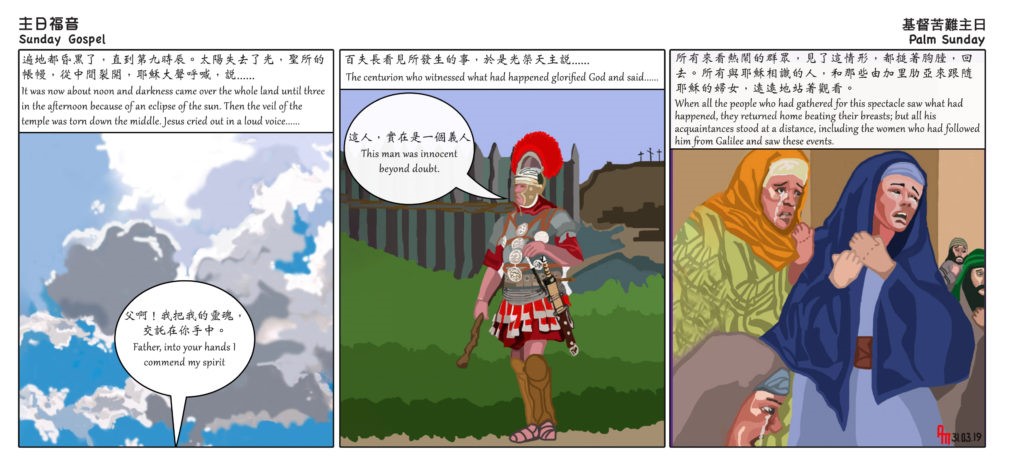Is 50:4-7, Phil 2:6-11, Lk 22:14-23:5
– May Tam
www.FLL.cc
One common feature among the Gospel writers was the way they narrated the passion and the death of Jesus. No longer were the sayings and deeds of Jesus arranged according to the writers’ intentions (for their specific communities), but all of them followed closely the sequence of the passion of Jesus chronologically beginning from His triumphal entry into Jerusalem. In our modern days, it would be like a cameraman recording the event over several days in what now popularly called reality show. Imagine if this reality show is now accessible electronically, what effects will it bring to the world?
Surely it may be the most publicized story ever reported. It may enrage activists who are against social injustice. It may infuriate humanitarians who are against cruelty. It may provoke advocates who are against capital punishment. It may generate sporadic protests or rallies to save that pitiful “criminal.” It may even be used to promote anti-Semitism.
Emotional responsiveness is easily stimulated by images we see, but how long can these images sustain our human sentiments? Fairly recent stories give way to ever newer stories each day. Their once sensational moments discolor even in a short period of time. The story of our Lord’s Passion, no matter how “real” and great it is, may not escape the fate of momentary remembrance and desensitization over time. How sad if that is the case, for then Christians “are of all people most to be pitied” (1 Cor 15: 19).
Thanks to our Holy Mother Church who, in her yearly celebration, reminds us of this great story and keeps it going for two thousand years. Our good Lord who knows our human weaknesses but loves us still, had commanded this story to be remembered in every liturgical worship, so that our faith can be revivified by His passion, death and resurrection.
Dear friends, what are our responses today if we see Jesus enter into Jerusalem in a live broadcast? Do we have the courage to watch Jesus when He prays in Gethsemane, ready to be arrested, judged and tortured? Can we withstand the grievances when He is being ridiculed and mocked? Are we in anguish when seeing Him fall flat on the road to Calvary? Do we dare to witness the moment when the nails puncture His hands and feet and then His last breath on the cross? Or do we, treating it as just another story, habitually switch the screen and put it out of our sight, out of our mind?
Being Compassionate in the Midst of Suffering
– Fernando Armellini SCJ
Claretian Publications, Macau
The passion narrative of Luke emphasizes the goodness and mercy of Jesus. He intervenes and severely rebukes Peter who countered the soldiers with his sword. Then he takes care of the wounded and healed him (Lk 22:51). The message that the evangelist wants to give is clear: the disciple not only cannot attack anyone but is always ready to remedy the troubles caused by others. He also takes care of those who did and still continues to want to hurt him.
In another touching incident, Peter, after his denials went out and wept. Luke notes the moving gaze of Jesus on Peter: it is not a reproach, but a gesture of sympathy for the weakness of his disciple. Luke indicates to Christians of all times how they should consider their own and their brothers’ fragility: they are looked at with Jesus’ eyes; eyes that instill confidence and hope, eyes that discover, even in the biggest sinner, a spark of love and help him to restart.
During the passion, Judas betrays, Peter denies, all others flee (Mk 14:50). In the agony of the garden, when the disciples are found sleeping, Luke finds an excuse to explain their sleep: “They were worn out of grief” (Lk 22:45). Luke is the example of the shepherd of souls who, while not justifying sin, understands it, attributes it to ignorance, human misery that unites us all. He does not emphasize the mistake done, does not accuse because he knows that whoever is humiliated and ashamed, ends up dangerously withdrawing, making the recovery impossible.
Only Luke records that, moments before his death on the cross, Jesus still has the strength to say: “Father, forgive them for they do not know what they are doing” (Lk 23:34). It will be imitated by Stephen, the first martyr who, with bended knees under the blows of stones hurled at him, will cry out loud: “Lord, do not hold this sin against them” (Acts 7:60).
Jesus, as every athlete before the competition, must prepare himself for the Passion and Luke – more than the other evangelists – emphasizes how he prepares himself: with prayer. The story of the agony begins with the recommendation of Jesus to the disciples: “Pray that you may not be put to the test,” then he continues: “he went away a little further and kneeling down, he prayed… Having entered in agony he prayed more earnestly … Then he rose from prayer … And he said the disciples: Get up and pray” (Lk 22:39-46). An insistence on prayer which aims to indicate to all Christians how to obtain victory.
Even in dying he became one with sinners dying between bandits to whom he offers his father’s kingdom.


 Follow
Follow


